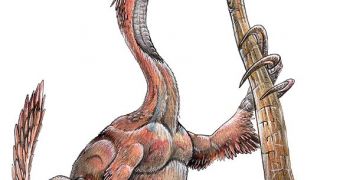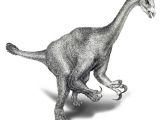T-rex might have been one of the most fearsome meat eaters ever to walk the Earth, but, surprisingly, there was a group of closely related dinosaurs that were plant-eaters; they were called the therizinosaurs. One of these odd waddling dinosaurs with long arms and enormous claws has been recently found in Gansu Province (northwestern China).
"It walked only on its hind legs like the carnivorous dinosaurs from which it evolved, but Suzhousaurus megatherioides, meaning "giant sloth-like reptile from Suzhou," was an herbivore. Suzhousaurus is unique in being the oldest well-known, very large member of this group of dinosaurs" said researcher Daqing Li of the Third Geology and Mineral Resources Exploration Academy of Gansu Province.
Li and his colleague Hailu You of the Chinese Academy of Geological Sciences discovered the fossil, mostly made up of the back vertebrae, the shoulder, the front leg and partially the hips.
Large therizinosaurs were more recent, living between 90 million and 65 million years ago (when dinosaurs disappeared), but Suzhousaurus is 115 million years old, belonging to the early Cretaceous Period.
Therizinosaurs are extremely changed coelurosauria theropod (feathered) dinosaurs (thus closely related to T-rex) that had turned vegetarian. Their teeth are smaller and leaf-shaped compared to the sharp, serrated teeth of most meat-eating theropods. "Therizinosaurs are thought to be closely related to birds. Based on the discovery of feather-like structures in one ungainly member of the group, Beipiaosaurus, therizinosaurs were probably all feathered," said co-author Matt Lamanna of Carnegie Museum of Natural History.
Therizinosaurs had a surprising anatomic detail: the three enormous claws on the forelimbs, which they could have used to pull tree branches towards their mouth when feeding, like extinct giant ground sloths and to defend themselves against large predators. Suzhousaurus was almost 22 ft (6.5 meters) long from head to tail.
"It is one of the largest known therizinosaurs, and probably the largest known from the Early Cretaceous. Its upper arm bone is among the longest-known of any theropod," said Lamanna.
"Suzhousaurus' closest known relative may be Nothronychus, fossils of which have only been found in somewhat younger rocks in New Mexico and Utah. This suggests that dinosaurs regularly traversed a transitory land bridge between North America and Asia early in the Cretaceous Period," said Lamanna and co-author Jerry Harris of Dixie State College of Utah.
"The most primitive known therizinosaur comes from Utah, so the group may have originated in North America, but they apparently evolved larger body size relatively quickly once they got to Asia." said Lamanna.
"The dinosaur lived on a warm, semi-arid plain dotted with shallow, temporary lakes. It shared its world with a host of other Early Cretaceous dinosaurs, including giant, long-necked, plant-eating sauropods and early relatives of duck-billed herbivores," said co-author Ken Lacovara of Drexel University.

 14 DAY TRIAL //
14 DAY TRIAL // 
